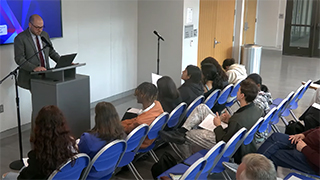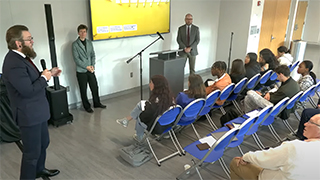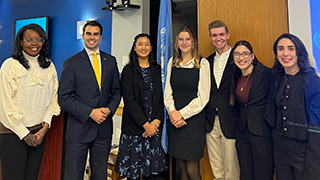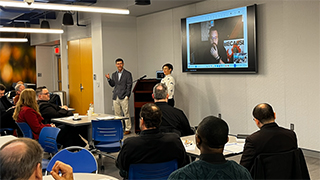“Way to Nicaea” Symposium Explores Lonergan’s Vision of Doctrinal Development
Monday, November 24, 2025
 Seton Hall University hosted an afternoon symposium about Bernard Lonergan’s book,
The Way to Nicaea, on October 23, bringing scholars, students, and community members together to examine
Bernard Lonergan’s account of the intellectual development of Nicene doctrine. The
event was held from 1:30–5 p.m. in the Event Lounge of the Bishop Dougherty University
Center and drew significant engagement, with about 45 attendees in person and more
than 100 joining via livestream.
Seton Hall University hosted an afternoon symposium about Bernard Lonergan’s book,
The Way to Nicaea, on October 23, bringing scholars, students, and community members together to examine
Bernard Lonergan’s account of the intellectual development of Nicene doctrine. The
event was held from 1:30–5 p.m. in the Event Lounge of the Bishop Dougherty University
Center and drew significant engagement, with about 45 attendees in person and more
than 100 joining via livestream.
The symposium was organized by the Bernard J. Lonergan Institute in honor of the 1700th anniversary of the Council of Nicaea. Its director, Jonathan Heaps, Ph.D., shared the origins of the event, saying, “This symposium began more than five years ago as a stray idea over dinner with colleagues in San Antonio, Texas and the anniversary of the Council of Nicaea gave me good reason to finally make it a reality. I'm grateful to the Center for Catholic Studies for helping to make it possible and to each of the scholars we invited for their thoughtful presentations.”
The afternoon opened with a welcome from the moderator, followed by the first panel featuring Monsignor Richard Liddy and Jeremy Wilkins, Ph.D. (Boston College). Their presentations engaged with the “Prolegomena” of Lonergan’s 1960s theological work, The Triune God: Doctrines, since published in English as The Way to Nicea. A question-and-answer session with attendees concluded the session.
The second panel featured Samantha Miller, Ph.D. (Whitworth University), and Joshua McManaway, Ph.D. (University of Notre Dame), who offered further interpretations of Lonergan’s historical-theological method before responding to audience questions.
The symposium capped an eight-week reading group hosted by the Lonergan Institute in the weeks prior, during which participants slowly read and discussed Lonergan’s Way to Nicea. That preparatory work fostered deeper engagement during the formal presentations.
The event drew heavily on the historical background of Lonergan’s work. Between 1955 and 1965, Lonergan taught a course in systematic theology at the Gregorian University in Rome called De Deo Trino (“The Triune God”). Over a decade, he produced a two-volume textbook for the course. The first volume, The Triune God: Doctrines (as it was later translated into English for his Collected Works), included a “Prolegomena,” tracing the intellectual development of the Council of Nicaea’s Christological and Trinitarian dogmas. This section was later published in 1976 as The Way to Nicea, translated by Conn O’Donovan.
Scholars have long praised the work’s historical depth, though Lonergan himself considered it incomplete, noting that “no one person could be expected to do everything that the [Gregorian University] setup was calling for.” His dissatisfaction would help inspire his 1972 book, Method in Theology, which proposed a collaborative, eight-part model of theological inquiry.
 The symposium highlighted how the intervening sixty years of scholarship have both
enriched and complicated Lonergan’s historical project, prompting scholars to revisit
and reassess his conclusions. The Lonergan Institute designed the event to honor Lonergan’s
hope that theology might function as a modern discipline.
The symposium highlighted how the intervening sixty years of scholarship have both
enriched and complicated Lonergan’s historical project, prompting scholars to revisit
and reassess his conclusions. The Lonergan Institute designed the event to honor Lonergan’s
hope that theology might function as a modern discipline.
Patrick Manning, Ph.D., the director of the Center for Catholic Studies, reflected, “This symposium was a most significant event. The presenters excavated the legacy of Nicaea from the dusty ruins of history, expertly communicating to the audience why the council was such a momentous event in the development of Christianity. Their erudition and generous engagement with participants and one another was a beautiful display of Catholic scholarship at its best.”
The conversation extended beyond Seton Hall. On October 24, Heaps, Miller, Wilkins, and McManaway traveled to Villanova University to repeat their panel presentations at the annual Patristics, Medieval and Renaissance Studies Conference. That session attracted around 20 attendees and concluded with a lively discussion.
Categories: Faith and Service






